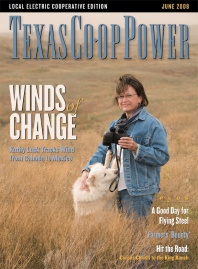San Angelo’s historic murals cast a magical spell over those who view them. Want to see for yourself? Stand in the parking lot at South Chadbourne Street and West Concho Avenue. Face north and close your eyes for a few seconds. Now open them.
In the blink of an eye, it’s 1908. Horse-drawn buggies roll down the 200 block of South Chadbourne. A man exits the Star Saloon, pushing open the swinging doors. People stroll past sidewalk signs advertising soda for 5 cents and blue material for 10 cents a yard. A sign at the Arc Light Saloon advertises beer, whiskey and dancing girls and admonishes patrons to check their firearms at the door.
A collision between a trolley car and vehicle draws a small crowd as local photographer McArthur C. Ragsdale, owner of the Ragsdale Building (since destroyed to make room for the parking lot), documents the accident.
The entire scene looks so real—and so big in this 20-by-85-foot mural painted on the wall of what is now a florist shop—that it almost seems possible to drive into the picture and cruise on down South Chadbourne Street, waving at people who lived here a century ago.
Mural artist Crystal Kedziora Goodman, who under the canopy of Historic Murals of San Angelo has painted three downtown wall murals over the past six years, said that’s the idea: Mix buckets of well-researched facts and no-peel paint, brushstroke in the most precise of details and watch people connect the present with a not-so-distant past.
On a chilly November afternoon, Goodman crawled down from her scaffolding on North Chadbourne Street, where under a separate city program she was painting a new façade on an old building to help restore its original look. Goodman said she loves to see people look in the murals’ mirrors to see yesterday.
“That’s not that long ago that we had the horse and the buggy and the trolley car and the men dressed in nothing but suits,” said Goodman, wearing white paint-stained pants and a sweatshirt bearing the Historic Murals slogan: “Our past has us up against the walls.”
Goodman continued, “When people drive down the street, it helps them remember this was just 100 years ago. That’s a drop in the bucket. I would love to live another 100 years to see how much it’s going to change from what it is right now. I can’t imagine.”
But thanks to Historic Murals—a nonprofit organization founded by Executive Director Susan Morris that meticulously researches all historical facts through the West Texas Collection at Angelo State University—people don’t have to imagine: They can see what the past looked like, down to the rattlesnake, tarantula and horned lizard standing guard as the six-horse Butterfield Stagecoach rolls by in the early public transportation mural.
“We don’t do anything we can’t substantiate,” Morris said, explaining that a big part of the process is poring through old photos.
Goodman’s work on the 1908 mural, completed in 2005, also drew from a Sanborn fire insurance map, which showed where businesses were located, and San Angelo’s first city directory, printed in 1908. And she painted in the trolley-car crash because it really happened.
But even with all the research, magic sometimes plays a role.
To wit, the blacksmith mural on South Oakes Street, the organization’s second mural, completed in 2003, brought an unexpected visitor while Goodman worked.
Almost every day, a man would sit on a bench across the street, silently watching as Goodman painted Frank Vogel, one of the city’s former blacksmiths, at work. Goodman added a blond-haired boy, a dog, a horse and a tree.
Before the mural was finished, Morris received a letter from Goodman’s mysterious onlooker, Bert Morgan (now 89), who said the mural bore an uncanny resemblance to his youth: Morgan, whose father owned a blacksmith shop across the street from where the mural was being painted, said he was once a blond-haired boy with a dog and that horses were often around. A big oak tree sheltered the blacksmith equipment.
Morgan remembered very specific details about his young life. For instance, he said he often had bloody toes from going barefoot. He wrote: “As I gazed at the painting a strange feeling came over me. I had a compelling urge to walk through the old weather-beaten door in the blacksmith shop and, like Alice through the looking glass, step 80 years back in time to my youth.”
After a teary-eyed Goodman read the letter, she changed one thing in the mural: She repainted the boy with bare feet.
It’s that painstaking attention to detail—even trash receptacles are being painted to complement the murals—that makes San Angelo’s murals seem larger than life. In the city’s first mural, a four-panel work completed in 2002 at South Chadbourne Street and West Avenue C, Goodman depicted the now-gone Santa Fe Depot—a gorgeous structure with Spanish architecture and handmade tiles.
The rest of the mural, which honors San Angelo’s early modes of transportation from 1840 through 1930, depicts the arrival of covered wagons; Locomotive 503, called the Iron Horse; and Cromwell Airlines, the first passenger plane service in San Angelo.
Meanwhile, Goodman paints in one special detail just for children: mice that are hidden in the murals.
Goodman said that years ago, when she was making ends meet by painting murals on children’s bedroom walls, she might have heard: “I want a big tree and I want seven apples and I want three pink flowers and I want green grass and I want a cow.”
Adults want something more evocative in a mural, a sense of time and place that spurs the imagination. “You’ll never look at a blank wall the same way again,” said Morris, who’s overseeing another downtown project in which murals are painted on canvasses and hung in storefront windows. “You’ll envision what kind of mural can go on it.”
For more information, go to www.historicmuralsofsanangelo.org.
——————–
Camille Wheeler is staff writer for Texas Co-op Power.


